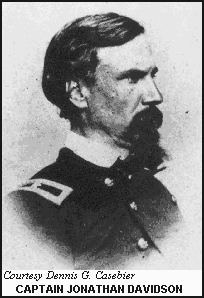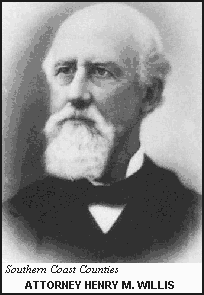Reports of Criminal and Secessionist Activity

San Bernardino - 1864
While Carleton was still assessing the need for assigning troops to San Bernardino, a number of prominent citizens from the city, and from Los Angeles, wrote to the military about their apprehensions regarding certain elements in their communities. Abel Stearns wrote of troublemakers among the Californios and Mexicans in Los Angeles, and said he was also worried about the Mormons, "whose hostility to our Government is well known, and who at any time may join the secessionists in our midst."
San Bernardino attorney Henry M. Willis, while campaigning for political office in Holcomb Valley, had gained information of secessionist activity in that area, and in an August 5th letter to Major Carleton, he specified those whom he thought to be involved, and gave detailed descriptions of their plans.
He reported that a Major Rollins, "the leader and moving spirit" of the secessionist effort, had been sent for out on the Mojave to address meetings in Bear and Holcomb Valleys. This implies that Rollins was headquartered on the desert, and is the first reference of many that some sort of encampment existed there. Many of the secessionist meetings were held in the Holcomb Valley store of Samuel Kelsey, who was described as enterprising, cautious and brave, and was said to instill treason into the youth of the county "with the subtlety of the devil."
In a dispatch dated August 13, 1861, U. S. Army Captain Jonathan Davidson of the 1st Dragoons, recognizing that the desert was being used for illegal activities, recommended that a military outpost be established at Martin's Ranch in Cajon Pass. A few weeks later Davidson, who had been ordered to San Bernardino with a contingent of dragoons and infantry, submitted a report stating he was convinced that the Mojave was to be a staging area for secessionists planning to commit robberies in the vicinities of Los Angeles and San Bernardino and then leave the state.
He said he knew that the "point of concentration" was on the Mojave and that a number of men had already arrived, but just exactly where this encampment was he did not know. This report has some credibility, because the desert, not only ideal as a rendezvous point and hiding place for gangs of horse thieves, was also the perfect location for a secessionist hideaway; it was convenient to the mining camps in Holcomb Valley -- an area that harbored a large number of Confederate sympathizers -- and was away from the scrutiny of both the military and civil authorities. However, the actual existence of any secessionist encampments on the desert was never confirmed, even though the military searched the Mojave for months.
Also during the month of August the Los Angeles Star had released a news story about a gang of outlaws from Salt Lake City headed by a man named Button, who, according to the report, was "a Mormon spy, or worse," operating out of a location in the town of San Bernardino that had become widely known as Whisky Point (in the vicinity of present-day Third and D Streets).
The Button Gang was purported to have made an unprovoked attack upon a responsible citizen, and the inference in the story was that the entire populace was in some danger from these "Salt Lake ruffians." The reporter asked, Why didn't Sheriff Anson Van Leuven arrest these fellows? Why didn't Major Carleton take charge? In what may have been an attempt to get Carleton's attention, the writer asserted that this was the gang that had destroyed a monument the Major had built at Mountain Meadows; and even further, he went on to accuse the gang of participating in the massacre itself, making the pronouncement, "...we are satisfied they took part in that fearful tragedy."
In this instance, it appears the Star far exceeded acceptable boundaries in its condemnation of the Mormons -- there was no evidence proffered for any of these accusations. Members of the community quite justifiably complained about the slanderous characterizations, as they saw them, being published by the newspaper.
One impertinent Star correspondent, siding with the paper, wrote that the truthful portrayal of "transient Salt Lakers" in the newspaper "has called down the ire and abuse of this amiable class of our community." The transients to whom the writer refers must have been the many Mormon families who had returned to Utah, only to find they could no longer live under the autocratic rule of Brigham Young, and were now seemingly uprooted and dispossessed, traveling from place to place.
Several years had passed since the Star had been an admirer of the Mormons and described them in complimentary terms. This change in attitude can be seen from the time of the Mountain Meadows Massacre. And during the Civil War years, since the paper was very pro-Southern, it was probably occasionally inclined to blame Mormons for some of the criminal activity that could otherwise be placed with the secessionist movement. The article on the Button gang is an excellent example.
The paper's accusation that the men lingering in the vicinity of Whisky Point were Mormon spies was refuted by Henry Willis, who, as both prosecutor and defense attorney in San Bernardino, was in a position to know the truth of those charges having to do with the local area. In his August 5th letter to Major Carleton, Willis gave a very different slant on the situation at Whisky Point:
-
Disregard the reports you read in the Los Angeles Star about the Mormons and Whisky Point. They and the men that reside there are Union men, and in this matter are unjustly libeled by a secessionist paper.
< Previous - Next >

